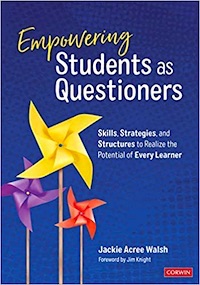Teaching Kids to Ask Questions That Matter
How can we encourage students to develop their own questions? And, once they create them, what’s next? Jackie Walsh explored these questions in a recent Corwin webinar – Archived here. And see all of our articles by Walsh here.)

What’s the one best way to enhance student engagement and excitement for learning, academic achievement, and citizenship in our democratic society?
That’s a challenging agenda, I know. But I’m convinced the answer is to develop kids’ capacity as questioners by strengthening the skill, nurturing the will, and creating an environment where learners experience the thrill of asking questions that matter.
While some educators might argue (with some justification) that students would ask questions if teachers would only allow it, most of us would agree that students benefit from learning the what, why, and how of questions, all of which contribute to their skill. Here’s a refresher.
Questions Come in Four Flavors
Four question types serve distinct functions in student learning and offer a teacher-tested frame for developing skills.
► Self-questions, posed silently to guide one’s learning and begin the process of personal meaning-making, strengthen students’ metacognitive functioning. These questions enable self-regulation—What are my learning goals? Where am I now in learning progression? What strategy will work best for me? Questions that support student comprehension while reading or problem-solving also fall into this category.
► Academic questions, asked aloud as students work to master daily learning targets, sound like: What does the author mean _____? Can you provide an example of ______? What contributed to ______?
► Exploratory questions, borne out of student curiosity, express student wonderings and puzzlements and both fuel the drive for new learning and lead students to new ways of thinking, to innovating and creating. These inquiries often begin with: What if ____ ? Can you imagine____ ? How might ____ ? I wonder why ____.
► Dialogical questions, motivated by the desire to get behind different points of view or interpretations, open up conversations that deepen understandings of academic content, or (very importantly) of the perspectives and beliefs of those who think differently. Prompts include: What led you to this conclusion ____? What makes you say that? Can you share an experience that reinforced this way of thinking? Is there another way of thinking about ____?
Students need to know both when and how to form and ask questions from each of these categories.
Nurturing Skill, Will, and – Thrill!
Among the strategies for developing student SKILL are (1) teacher modeling with think-alouds; (2) provision of tools including criteria for forming and assessing questions, sample prompts and stems; (3) identification and use of appropriate routines and protocols to scaffold practice, and (4) structured opportunities for reflection and peer feedback.
Students may possess the skill for forming questions, but lack the WILL – the confidence, the motivation – to do so. Impeding student will is the traditional student role: Students are to answer, not ask, questions.
I advocate explicit teaching of new mindframes that convey the value of asking questions. For example, to encourage academic questioning, spend time helping students unpack and make personal meaning of this mindframe: I form and ask questions to clarify and deepen my understanding of academic content.
Introduce similar mindframes for other question types, post these, and reference during daily lessons when appropriate. Pause during lessons to afford students time to reflect and form questions. Encourage the recording of questions in journals or on public charts and pause during explicit instruction (think time 2) to allow questions.
Most importantly, use student questions to structure lessons. Support students as they work individually and collectively to pursue their questions by assisting in identification and use of reliable resources for research. Help them refine their questions to guide class dialogue. All of these teacher gestures communicate respect and show we value student questions, which serves to strengthen student will to accept this new role.
A class environment nurturing the THRILL for questioners emerges when students know their questions are charting their learning journey because questions are more highly valued than answers. The thrill heightens as their questions lead to aha moments that are celebrated by competent, confident members of a classroom community brimming with inquirers.
What’s quality questioning like in real classrooms?
Read a teacher’s story at Corwin Connects.

Jackie is also senior consultant for the Alabama Best Practices Center and for its Key Leaders and Powerful Conversations professional learning networks. She lives in Montgomery.





































